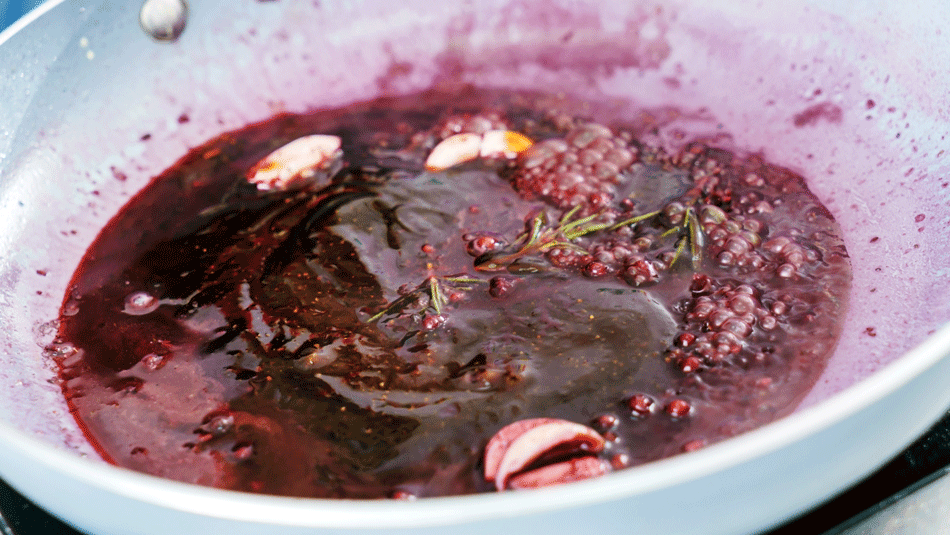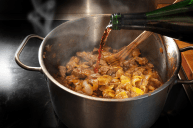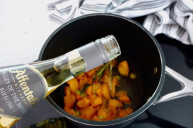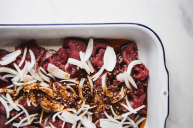It is no secret that an adult beverage can enhance the flavors of your meal. Yet, as powerfully as alcohol can enhance the flavor of food once it is on the table, its real power lies in what it can do when used in the kitchen.
Videos by Wide Open Country
Just like salt, alcohol is a flavor enhancer. Its unique chemical properties make wine, beer, rum, whisky, and vodka much more than an accompaniment to a meal. Each alcohol lends its unique flavor profile to a dish. Think beer bread, rabbit braised in red wine, bourbon cherry sauce. With so many classic recipes where alcohol is a major component, it seems that the proof is in the pudding, or the casserole, or the... well you get the point.
Aren't you curious to see how a splash of something a little stronger can liven up your cooking routine? Take a look at how the different varieties of alcohol work in harmony with your food to give unexpected depth and unparalleled complexity to even the simplest of dishes.
White Wine
https://www.instagram.com/p/BOziyHmh1xm/?tagged=whitewine
White wine, especially dry, crisp ones like Sauvignon Blanc, is a great everyday cooking alcohol. You can use it in sauces, it can help you deglaze skillets, and it is wonderful for marinating or poaching lightly flavored meats.
The beauty of cooking with a Sauvignon Blanc in particular is that its bright, crisp, green flavor will blend perfectly with most dishes. It's light enough that it won't overpower your dishes, but it's complexity of flavors is sure to please most pallets.
Other good white wines to use when you want to switch it up are Chardonnay, Riesling, and Pino Grigio.
Red Wine
When you cook with red wine, there is so much variety that you will never tire of playing around with the flavor profiles of different blends.
Zinfandels can offer fruity and peppery notes to your dishes. Côtes du Rhône come in a variety of styles depending on the blend and can range from fruity to full bodied.
Cabernet is full of tannins and can brighten up a dish with an acidic flavor. Pinot Noir is a classic cooking wine with berry and earthy undertones, which allows it to pair effortlessly with meat heavy dishes.
Cooking with red wine comes down to a matter of taste. The only two general rules that you should follow when selecting your wines.
1. Don't choose any heavily oaked wines that will make your sauces bitter.
2. Avoid extremely tannic wines that will make your sauce harsh and acidic.
Beer
Like wine, beer is a staple ingredient in the nuanced chef's pantry. Not only does it lend an enhanced flavor profile to a dish, but it also has natural enzymes that help tenderize meat, making it a perfect ingredient in a marinade.
In terms of flavor, beer adds a rich nuttiness to soups and stews that makes them taste like they've been simmering for hours even if you just whipped them up an hour before.
Even more surprisingly, beer that has sweet and nutty overtones can add a toasty, malty depth and help reinvent classic desserts.
Bourbon
Bourbon is a great alcohol to add to a sauce or allow fruit to soak in.
Its honey-like taste transfers easily into food leaving a hint of sweetness and deep molasses undertones to anything you've added it to.
Whiskey
Whisky is a grain liquor that is the alcoholic version of salt. It brings out the sea in seafood, the smoke in cured meats, and the sweetness in dessert.
Plus, the unique aging process of whisky gives it a wide range of flavors from citrus to peaty, which will be soaked up into your dish and allow you to play with flavors when you splash a dram into your sauce pan.
Rum
Rum is the golden standard of cooking liquor if you like a caramelized flambée finish. Made from sugar cane, rum is a perfect liquor to add a little interest to your desserts. Its natural caramel flavor pairs well with bananas, tropical fruits, and cakes.
If you prefer something a little spicier, you can try spiced rum. With hints of cinnamon, nutmeg, and cloves, spiced rum is a great addition to any fall-weather dish.
Vodka
Cooking with vodka has surprising advantages. Not only does it have a clean and mild flavor that does wonders to enhance tomatoes, but it is a fantastic addition to baked goods.
If you are trying to create that perfect, flaky, melt-in-your-mouth crust then you need to add a splash of vodka. Most of the time recipes call for using minimal water in order to preserve the flakiness of the dough. However, that can make the dough difficult to work with.
Therefore, instead of adding more water, which produces gluten and makes your crust sticky, add vodka. When it bakes, the alcohol will evaporate preventing extra gluten from forming, and you will be left with a tender, flaky crust - no vodka flavor included.
Vanilla
Not everyone knows that vanilla is actually alcohol-based. Unless you are using imitation vanilla, the real deal is vanilla beans that have been soaked in alcohol.
This means that instead of being a non-alcoholic substitute, it is in fact just as alcoholic as the liquor it was made with.




